Top 9 Benefits Of Rowing Machine Workout/Exercises
All you need is to use just one machine to get the body you have always wanted.

Image: StyleCraze Design Team
Rowing is one of the best full-body workouts. The benefits of rowing machine exercise include burning 200 calories in a 30-minute session, improving lower body and upper back muscle tone, enhancing your strength and endurance, and helping in power training as it causes increased lung capacity and heart rate. The exercise targets the lats, shoulders, chest, hamstrings, quads, glutes, calves, biceps, and triceps (1). Rowing machines provide a full-body workout without stressing your joints, making them ideal for all fitness levels. With adjustable resistance, they can be tailored to suit both beginners and experienced athletes. This flexibility makes rowing accessible to people of all abilities. Read on to know the 9 best benefits of the rowing machine exercise. Swipe up!
 Workout Blueprint: Rowing Machine Exercises
Workout Blueprint: Rowing Machine Exercises- Frequency: 2-4 times per week
- Benefits: Improve muscle strength and reduce belly fat.
- Equipment Needed: Rowing machine
- Space Required: Big area
- Assistance Required: No
- Who Should Avoid: Anyone with high blood pressure, back pain, or knee injury.
In This Article
9 Benefits of Rowing Machine Workout/Exercises
1. Effective Calorie Burner
Rowing machine exercises are gasoline for stored fat.
Ten minutes of a rowing machine workout burns 100-200 calories, depending on your body weight, intensity, and resistance used.
2. Great Full-Body Workout
Apart from working on your upper back muscles, rowing machine exercises also target your core, chest, biceps, forearms, hamstrings, and quadriceps.
Therefore, you get a full-body workout without having to hop from one machine to the other.
3. Improves Muscle Strength

Rowing machine exercises help in upper body workout as it improves upper body strength and shows enhanced endurance capacity (or stamina). Researchers have found that rowing machine workout helps people with spinal cord injury regain muscle strength (2).
4. Great For The Heart And Lungs
Rowing exercises help improve heart and lung function. Depending on the reps, sets, and resistance used for the exercises, you sweat and breathe in more oxygen, making your heart work harder to meet the oxygen demands.
5. Helps Build Muscle
Rowing exercise activates your muscles and causes wear and tear. When you rest and sleep, these muscles rebuild themselves stronger and thicker to give you that lean look.
6. Low-Impact And Low-Risk Activity

Rowing exercises are great for people with knee joint pain or arthritis. They are low-impact and easy on the joints and increase joint flexibility. Rowing machine workouts also have a reduced risk of injuries. Make sure not to add too much resistance; add as much resistance that allows you to do 3 sets of 15 reps with ease. Add more resistance gradually as your strength increases.
7. Tones The Arms
Rowing machine exercises work on your arms, especially the triceps and wrists.
Triceps are the muscles present at the back of your upper arm. Extending and pulling the rowing handle helps tone the triceps and forearms. Over a period, your arms start to look slimmer and more toned.
8. Reduces The Risk Of Diseases
Upper body fat is closely linked to metabolic complications of obesity (3). Getting rid of upper body fat helps reduce the risk of developing obesity-related diseases.
9. May Reduce Belly Fat
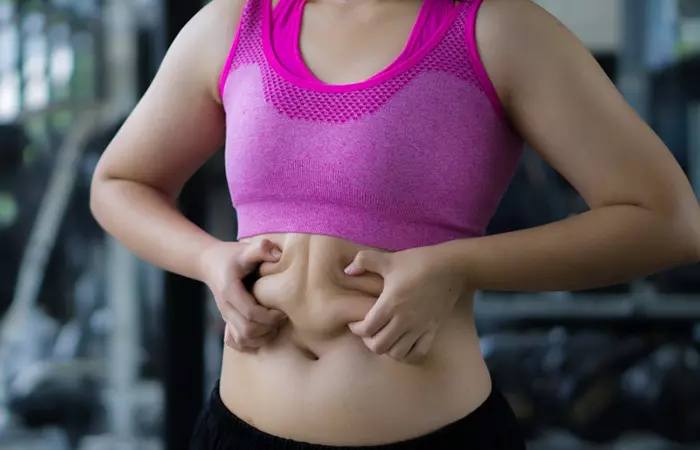
Rowing exercises work on your ab muscles. They are also good cardio and burn a good number of calories. Therefore, they can help you lose overall fat and tone up your belly region.
Johnny Luk, a blogger, has practiced river rowing since he was 13 years old. However, he decided to step away from professional rowing during his time in university, as the training was too strenuous and he lost his love for the sport. He also noted that his back started to get sore. About river rowing he writes, “ Any river rower would tell you the sheer fear of doing an ergo test, the absolute exhaustion doing a 2k or a 30 minute full effort row.” He properly got back to rowing in 2020, but this time he was trying indoor rowing using a machine. Discussing the change to indoor rowing, he adds, “Since then, it has changed my life. Rowing has come a long way since my school days…Surprisingly, it’s also strengthened my back (i)!”
 Quick Tip
Quick TipKey Takeaways
- Exercise on a rowing machine can enhance cardiovascular health.
- It can aid in boosting muscular stamina and endurance.
- You can also improve your balance and posture through these exercises.
- Rowing machine exercise may also lower stress and enhance mental well-being.
6 Rowing Machine Workouts
1. Row Warm-Up
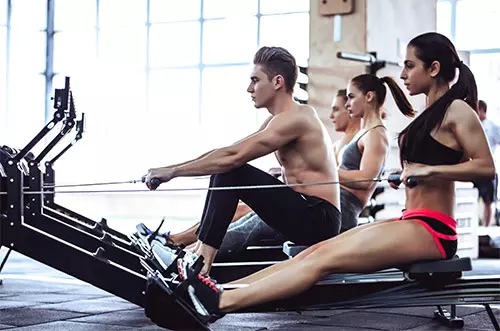
Before you start a full rowing machine workout, you must warm-up. Here’s how to do it.
How To Do
- Add low resistance. Sit on the rowing machine, hold the pulley’s handle with your hands extended, core engaged, and back straight.
- Place your legs on the leg rest. Keep them extended.
- Pull the handle to your chest. Do not move back or hunch your back.
- Slowly get your hands back to the starting position.
- Do this 5 times.
- Pull the handle and move forward as you extend your hands again.
- Do this 5 times.
- Pull the handle of the pulley and as you extend your hands again, bend your knees and slide forward.
- Slide back as you pull the handle of the pulley.
2. Simple Rowing

How To Do
- Sit on the rowing machine and place your feet on the leg rest.
- Extend your arms and grab the handle firmly in your hands. Make sure your back is not hunched and your abs are tight.
- Push with your legs, straightening them until they are completely extended. Pull the handle with your extended arms at the same time.
- Lean back a little while keeping your arms extended.
- Pull the handle close to your chest. Squeeze your shoulder blades and do not lean back any further while doing so. Use your back muscles to pull the handle.
- Bend your knees and slide forward as you extend your hands.
3. Water Rower Workout
This is similar to the simple rowing exercise. There is just a slight difference in the machine design.
Here’s an inspiring video featuring Josh Crosby, World Champion Rower, doing this exercise!
4. Power Curls
How To Do
- Do the simple rowing exercise 3 times.
- When you go back and bring the handle close to your chest, curl your hands by flexing your elbows, just like you would while doing bicep curls.
- Release the curl and slide forward, bending your knees.
- Repeat the whole exercise 5-8 times.
5. Sprints Or Extreme Rowing
How To Do
- In this exercise, you do the regular rowing exercise, but without taking the handle all the way back. Increase the speed of rowing while stopping in the Drive position.
- Do as many as you can in 1 minute.
- To intensify the exercise, you can increase the duration and speed of rowing.
6. Tabata Rowing Workout
How To Do
- Start with a brief warm-up to get your muscles and joints ready.
- Tabata workouts are all about timing. You will work hard for 20 seconds and then rest for 10 seconds. Set a timer or use a Tabata app to keep track.
- Sit on the rowing machine and row at maximum intensity for 20 seconds during the “work” phase. Push through your legs and pull with your arms.
- Take a 10-second break after the intense 20 seconds. While it is quick, it is important for recovery.
- Continue this pattern for 8 rounds or for 4 minutes.
- Once done, spend a few minutes rowing at a slower pace to cool down and lower your heart rate.
 Quick Tip
Quick TipPractice these six exercises to see a visible difference in your energy, appearance, and well-being.
Infographic: Things To Know Before Using A Rowing Machine
A rowing machine workout is one of the best High-intensity interval training (HIIT) workouts, which may aid in cardiovascular fitness that allows total body conditioning. It can help build stamina and strengthen your lower body. However, you should know how to use a rowing machine properly to reap maximum benefits. Check out the infographic below to learn the key points you should remember before using it. Illustration: StyleCraze Design Team
From burning calories effectively and losing belly fat to strengthening the upper body and improving heart and cardio respiratory health, the benefits of rowing machine exercises are wide-ranging. The exercises discussed above primarily work on your core, chest, biceps, triceps, hamstrings, quadriceps, forearms, wrists, and ab muscles. These low-risk and low-impact exercises are ideal for those with knee injuries, while they also help reduce the risk of obesity-related diseases. So, do these exercises at least twice a week and strengthen your upper body. Visit your physiotherapist in case of any difficulties.
Frequently Asked Questions
How does rowing compare to other forms of cardio?
Rowing is a unique form of cardio because it works both your upper and lower body, giving you a full-body workout. Unlike other cardio exercises like running, it is low-impact, so it is gentler on your joints.
Can you lose belly fat on a rowing machine?
Rowing machine workouts work on your core strengthening. So, yes, you might lose some belly fat. But remember, belly fat is stubborn. You might need to follow these tips to get rid of belly fat.
How long should you workout on a rowing machine?
Start with 10 minutes and increase the time and resistance as you build strength and stamina.
How many days a week should you use a rowing machine?
Two times a week is ideal for rowing machine exercises.
How does a rowing machine differ from a treadmill?
On the treadmill, you walk or run. It does not target your upper back muscles.
Can you lose weight on a rowing machine?
Yes, rowing machine workout helps in calorie burning, so you will lose upper back fat.
Is rowing machine bad for the back and knees?
Rowing machine exercise may hurt your knees or back if you do not sit upright or if there is a disbalance between your two feet. If you experience pain after doing rowing exercises, seek your doctor’s advice. Also, you must take your fitness trainer’s help to first get used to the machine and learn about correct postures.
Is rowing machine bad for the hips?
No, it is not bad for your hips. But if you have tight hip muscles, you must talk to your trainer and doctor before doing rowing machine exercises.
How long should a beginner row?
Start with 3 sets of 12 reps. Gradually increase the sets and reps as you build more strength and stamina.
Is Rowing Everyday Good For You?
Some people prefer rowing every day. Others like to row on their back workout days. The best way to know is to talk to your trainer and design a workout plan that suits you and your body’s needs. Rowing also helps people think, just like running or meditating. If rowing does not cause any discomfort or pain, you may go ahead and row every day to reap these health benefits.
How can I make my rower seat more comfortable?
Placing a soft cushion between your sitz bones and the hard equipment seat can help to relieve pressure and make your rower seat more comfortable. Once you feel more at ease in the seat, you will be able to row for longer and feel better about each session.
Illustration: Benefits Of Rowing Machine WorkoutExercises
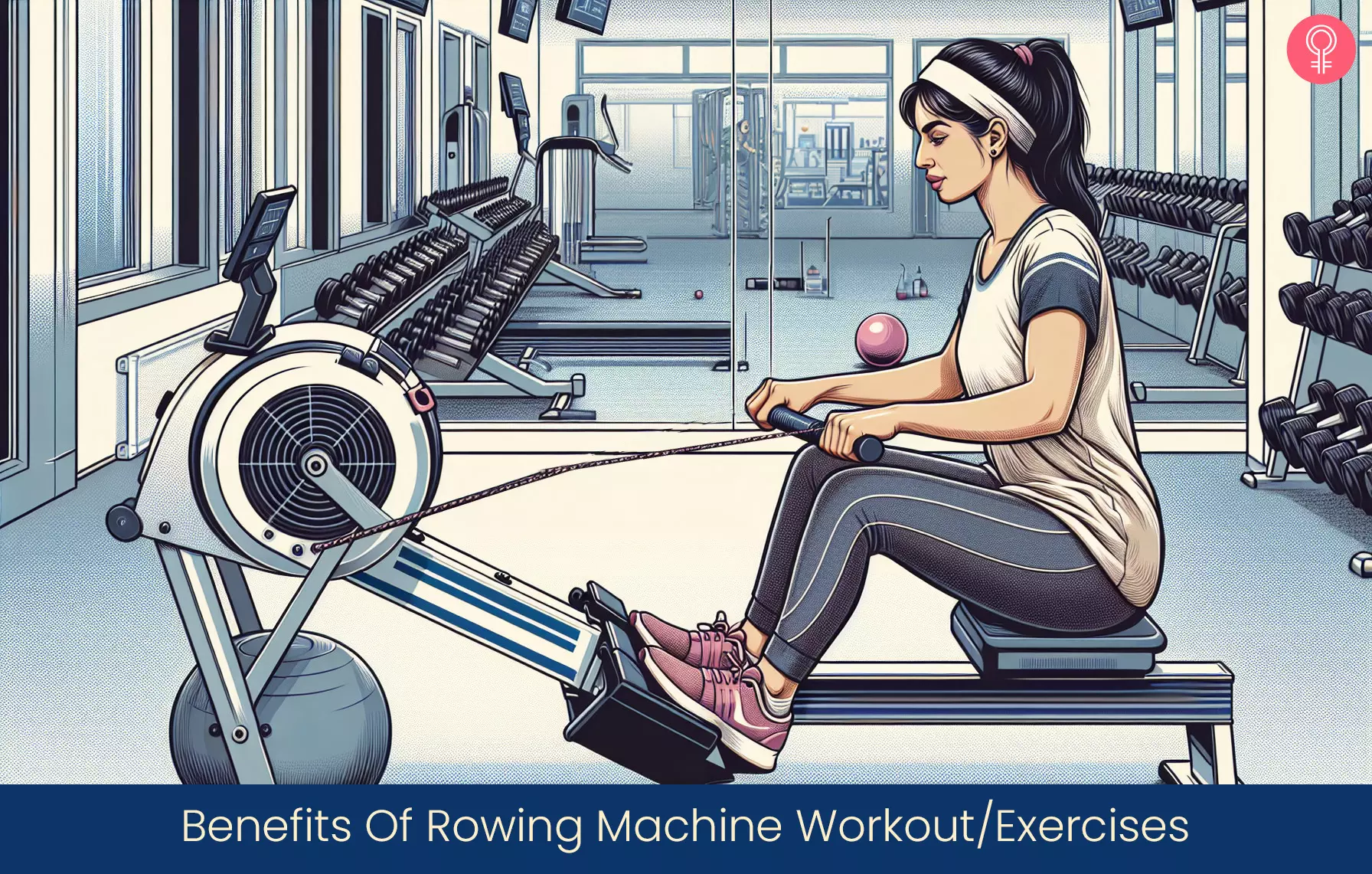
Image: Dall·E/StyleCraze Design Team
References
Articles on StyleCraze are backed by verified information from peer-reviewed and academic research papers, reputed organizations, research institutions, and medical associations to ensure accuracy and relevance. Read our editorial policy to learn more.
- Comparative analysis of basal physical fitness and muscle function in relation to muscle balance pattern using rowing machines, Bio-medical Materials and Engineering, US National Library of Medicine, National Institutes of Health.
https://pubmed.ncbi.nlm.nih.gov/25226943/ - A six-week motor-driven functional electronic stimulation rowing program improves muscle strength and body composition in people with spinal cord injury: a pilot study, Spinal Cord, US National Library of Medicine, National Institutes of Health.
https://pubmed.ncbi.nlm.nih.gov/24891008/ - Role of Body Fat Distribution and the Metabolic Complications of Obesity, The Journal of Clinical Endocrinology and Metabolism, US National Library of Medicine, National Institutes of Health.
https://www.ncbi.nlm.nih.gov/pmc/articles/PMC2585758/
Read full bio of Dr. Sudhansu Singh
Read full bio of Ravi Teja Tadimalla
Read full bio of Himanshi Mahajan








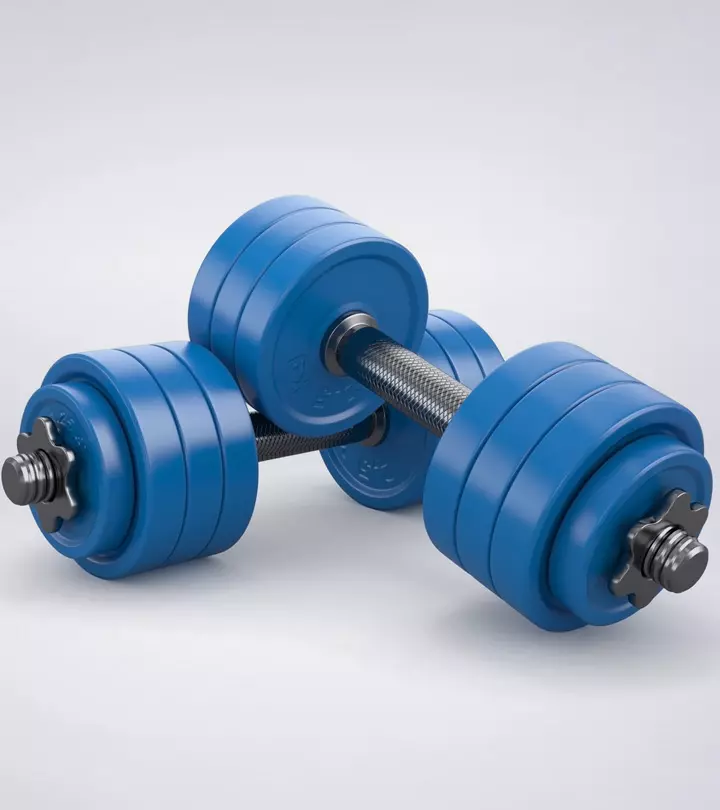
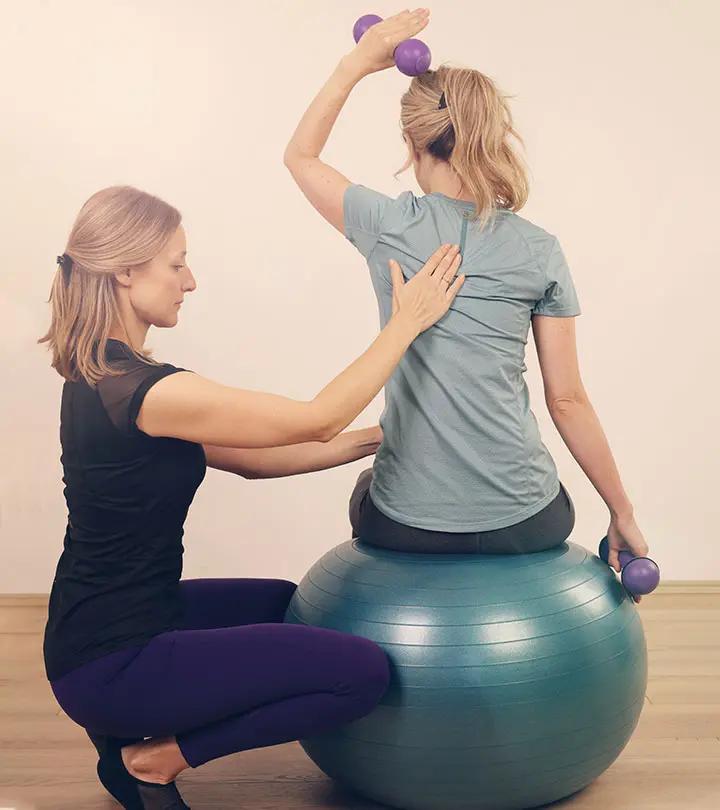
















Community Experiences
Join the conversation and become a part of our empowering community! Share your stories, experiences, and insights to connect with other beauty, lifestyle, and health enthusiasts.